Sinop Battle 18 (30) November 1853 g. Part of 2
Emperor Nicholas I
Battle
At dawn 18 (30) November, Russian ships entered Sinop Bay. At the head of the right column was the flagship of Pavel Nakhimov "Empress Maria", at the head of the left - "Paris" of Fyodor Novosilsky. The weather was unfavorable. In 12 hours 30 minutes Ottoman flagship 44-gun "Avni-Allah" opened fire, followed by firing guns of other ships and coastal batteries. The Ottoman command hoped that a strong barrage of naval and coastal batteries would prevent the Russian squadron from breaking through at close range, causing the Russians to retreat. May lead to severe damage to some ships that can be captured. The ship Nakhimov led the way and closest to the Ottoman ships. The admiral stood on the captain's cabin and watched a violent artillery battle unfolding.
The victory of the Russian fleet was identified in two hours and a little. The Turkish artillery, bombarded the Russian squadron with shells, was able to cause significant damage to some ships, but was unable to sink any. The Russian admiral, knowing the techniques of the Ottoman commanders, foresaw that the main enemy fire would initially focus on the mast (the deck parts of the ship equipment), and not the decks. The Turks wanted to disable as many Russian sailors as possible when they would remove the sails before putting the ships on anchor, and also to break the controllability of the ships, to impair their ability to maneuver. And so it happened, the Turkish shells broke yards, cusps, and sails. Thus, the flagship of Admiral Nakhimov assumed a significant part of the enemy strike, most of his spar and standing rigging was interrupted, only one guy remained untouched at the mainmast. After the battle, 60 holes were counted in one side. However, the Russian sailors were down, Pavel Stepanovich ordered the ships to be anchored without removing the sail armament. All orders Nakhimov were executed in accuracy. The frigate “Avni-Allah” (“Aunni-Allah”) did not withstand the confrontation with the Russian flagship and in half an hour rushed ashore. So, the Ottoman squadron lost control center. Then the "Empress Maria" fell asleep with shells 44-gun frigate "Fazli-Allah", which also could not stand the duel and rushed to the shore. The admiral transferred the fire of the battleship to the battery number XXUMX.
The ship "Grand Prince Konstantin" fired at the 60-gun frigates "Forever-Bahri" and "Nesimi-Zefer", 24-gun corvette "Nedzhmi Fishan", the battery number 4. “Navek-Bahri” went off the air within 20 minutes. One of the Russian shells hit the powder magazine. This explosion has disabled the battery number XXUMX. The corpses and wreckage of the vessel cluttered the battery. Later, the battery resumed fire, but it was weaker than before. The second frigate, after he had broken the anchor chain, brought to shore. Turkish corvette could not stand the duel and rushed to the shore. "Grand Duke Constantine" in the Battle of Sinop received 4 holes and damage to all masts.
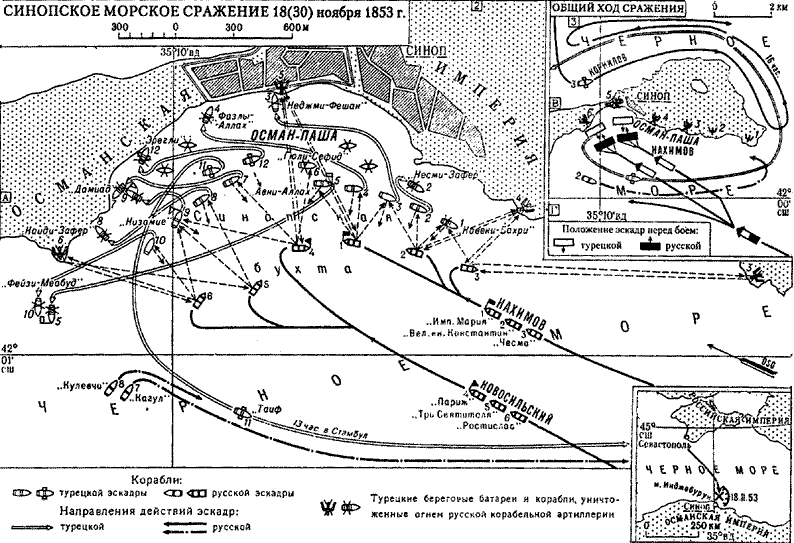
The battleship Chesma, under the command of Viktor Mikryukov, fired on batteries No. XXUMX and No. XXUMX. Russian sailors clearly followed the instructions of Nakhimov about mutual support. When the ship "Konstantin" was forced to fight immediately with three enemy ships and the Turkish battery, "Chesma" stopped firing at the batteries and concentrated all the fire on the Ottoman frigate "Navek-Bahri" that attacked Konstantin fiercely. The Turkish ship, hit by the fire of two battleships, blew up. Then "Chesma" put down the enemy batteries. The ship received 4 holes, damage to the mainmast and bowsprit.
In the same position, when the principle of mutual support was fulfilled, the ship "Three Saints" was half an hour later. The battleship under the command of K.S. Kutrov fought with the Qaedi-Sefer 54-gun frigate and the Nizamiy 62-gun. Enemy shots from the Russian ship interrupted the spring (the cable to the anchor holding the ship in a predetermined position), the Three Saints began to roll down the stern to the enemy. The ship has undergone the longitudinal fire of the battery №6, its mast seriously suffered. Immediately, Rostislav, under the command of the captain of the 1 rank A.D. Kuznetsov, who himself was subjected to heavy shelling, stopped return fire and concentrated all his attention on the battery No.6. As a result, the Turkish battery was demolished. "Rostislav" also forced to throw themselves on the shore 24-cannon corvette "Feise-Meabud." When Midshipman Varnitsky was able to repair the damage on the "Saint", the ship began to successfully fire at the "Qaedi-Sefer" and other ships, forcing them to be thrown onto the shore. The Three Prelates received 48 holes, as well as damage to the stern, all the masts and bowsprit. Help wasn’t cheap either for the Rostislav, the ship almost blew up, a fire started on it, the fire was getting close to the camera, but the fire was eliminated. Rostislav received 25 holes, as well as damage to all masts and bowsprit. More than 100 people from his team were injured.
IK Aivazovsky "120-gun ship" Paris "".
The second Russian flagship Paris led an artillery duel with the 56-cannon frigate Damiad, the 22-cannon corvette Gyuli Sefid and the central coastal battery No. XXUMX. Corvette caught fire and flew into the air. The battleship focused fire on the frigate. "Damiad" could not stand the strong fire, the Turkish team chopped off the anchor line, and the frigate threw ashore. Then "Paris" was attacked by 5-gun "Nizamiye", on which Admiral Hussein Pasha held the flag. The Ottoman ship lost two masts - fok- and mizzen-mast, it started a fire. "Nizamie" rushed to the shore. The commander of the ship Vladimir Istomin in this battle showed "fearlessness and firmness of spirit", made "prudent, skillful and quick orders." After the defeat of "Nizamie" "Paris" focused on the central coastal battery, it had a great opposition to the Russian squadron. Turkish battery was depressed. The battleship received 62 holes, as well as damage to the stern and gondek.
A.P. Bogolyubov. The extermination of the Turkish fleet in the Battle of Sinop. 1854
Taif steamer escape
It must be said that the presence in the Turkish squadron of two steam-frigates seriously puzzled the Russian admiral. At the beginning of the battle, Nakhimov did not have steamboats; they arrived only at the very end of the battle. The high-speed Taif, under the command of the British captain, could well manifest itself in a battle, when the Russian ships were tied up in battle, and their sail armament was damaged. Sailing ships in these conditions could not easily and quickly maneuver. Nakhimov was so reckless with this threat that he devoted to her a whole point of his disposition (No. 9). Two frigates were left in reserve and were given the task of neutralizing the actions of enemy steam-powered frigates.
However, this reasonable precaution did not materialize. Nakhimov evaluated the possible actions of the enemy on their own. He was ready to fight even in conditions of complete superiority of the enemy, Turkish commanders thought otherwise. So, during the battle, the commander of the corvette "Feise Meabud" - Izzet-Bei, escaped from the ship, from the steamer "Erekli" - Ismail-Bey, and some other officers were not up to par. The commander of the "Taif" Adolph Slade was an experienced commander, but he was not going to fight to the last drop of blood. Seeing that the Turkish squadron is facing destruction, the British captain skillfully maneuvered between Rostislav and the battery number XXUMX, left the raid and rushed to Istanbul. He had the task to follow and inform, and not to lay down his life for the interests of Turkey.
The Kulevchi and Cahul frigates attempted to intercept the enemy, but they could not keep up with the fast steamer. Slade changed course directions several times, knowing that large sailing ships would find it difficult to quickly change course. Breaking away from the frigates "Taif" almost fell into the hands of Kornilov. A detachment of steam-powered frigates Kornilov hurried to the aid of Nakhimov's squadron and collided with Taif. However, Slade was able to damage the ship "Odessa" and broke away from the "Crimea" and "Chersonese." As a result, "Taif" was able to go to Istanbul.
I. K. Aivazovsky. “Sinop. The night after the battle 18 November 1853 of the year. "
Results
The Ottoman squadron was almost completely destroyed. During the three-hour battle, the Turks were defeated, their resistance broken. A little later, they suppressed the remaining coastal fortifications and batteries, finished off the remnants of the squadron. One by one Turkish ships flew into the air. That Russian bombs fell into the powder cellar, or they got to the fire, often the Turks themselves set fire to the court, leaving them. The coastal batteries were finally razed to the top of the 17 clock.
Russian sailors destroyed 15 from 16 of enemy ships, suppressed all Turkish batteries. We flew into the air and turned into a pile of fragments of a 4 frigate, a corvette and a steamer, their teams almost completely died. Three frigates and one corvette were set on fire by the Turks themselves. The remaining vessels, smaller, also died. The Turks lost about 3 thousand people, the British reported 4 thousands. Just before the battle, the Ottomans were so confident of victory that they were preparing for boarding and put additional soldiers on ships. The explosions on the batteries, fires and explosions of beached ships led to a strong fire in the city. Sinop was badly hurt. The population, government and garrison of Sinop fled to the mountains. Later, the British accused the Russians of deliberate cruelty towards the townspeople. 200 people got into Russian captivity. Among the prisoners was the commander of the Turkish squadron, Vice-Admiral Osman Pasha (he had his leg broken in battle) and two ship commanders.
Russian ships in four hours fired about 17 thousand shells. The battle of Sinop showed the importance of bombing weapons for the future development of the fleet. Wooden ships could not resist the fire of such guns. It was necessary to develop the armor protection of ships. The highest rate of fire showed gunners "Rostislav". From each gun of the operating side of the battleship 75-100 shots were made. On the other ships of the squadron, 30-70 shots were fired with every weapon on the active side. Russian commanders and sailors, according to Nakhimov, showed "true Russian courage." The advanced system of education of the Russian seaman, developed and implemented by Lazarev and Nakhimov, proved its superiority in battle. Persistent training, sea trips led to the fact that the Black Sea Fleet passed the "Sinop Exam" perfectly.
Some Russian ships received significant damage, then they were towed by steamers, but all remained afloat. Russian casualties amounted to 37 killed and 233 injured. Everyone noted the highest skill of the Russian admiral Pavel Stepanovich Nakhimov, he correctly took into account his forces and the forces of the enemy, went to a reasonable risk, leading a squadron under the fire of coastal batteries and the Omani squadron, worked out a detailed plan for the battle, showed decisiveness in achieving the goal. The absence of dead ships and relatively low losses in manpower confirm the rationality of the decisions and the naval skill of Nakhimov. Nakhimov himself was, as always, modest and said that all the credit belongs to Mikhail Lazarev. The battle of Sinop was a brilliant point in the long history of the development of the sailing fleet. It should be noted that Lazarev, Nakhimov and Kornilov understood this very well, being supporters of the rapid development of the steam fleet.
N.P. Medovikov. P.S. Nakhimov during the Sinop battle 18 in November 1853 g. 1952 g.
At the end of the battle, the ships carried out the necessary repairs and 20 November (2 December) was removed from the anchor, moving to Sevastopol. 22 (December 4) Russian fleet with a general glee entered the Sevastopol raid. The entire population of Sevastopol met a victorious squadron. It was a great day. Endless "Hooray, Nakhimov!" Rushed from all sides. The lime, about the crushing victory of the Black Sea Fleet, rushed to the Caucasus, the Danube, Moscow and St. Petersburg. Emperor Nicholas awarded Nakhimov with the Order of St. George 2 degree.
However, Pavel Stepanovich Nakhimov himself was concerned. The purely military results of the Battle of Sinop Nakhimov was pleased. The Black Sea Fleet brilliantly solved the main task: eliminated the possibility of a Turkish landing on the Caucasian coast and destroyed the Ottoman squadron, winning complete supremacy in the Black Sea. Colossal success was achieved with little blood and material losses. After a hard search, battle and crossing the sea, all the ships successfully returned to Sevastopol. Nakhimov was pleased with the sailors and the commanders, they kept in a hot battle superbly. The testimony of contemporaries say that Nakhimov possessed strategic thinking and understood that the main battles were still ahead. Sinop victory will cause the appearance on the Black Sea of the Anglo-French forces, who will use all efforts to destroy the combat-ready Black Sea fleet. The real war has just begun.
The battle of Sinop caused complete confusion in Constantinople. The Grand Vizier even ordered frigates to sail 4 into the sea. Apparently, they were afraid of the appearance of the Russian fleet at Constantinople. In Paris and London, they first tried to belittle and diminish the significance of the feat of the Nakhimov squadron, and then when it became useless, as details of the Sinop battle appeared, envy and hatred arose. As Count Alexei Orlov wrote, “we are not forgiven by either skilful orders or the courage of execution.” In Europe, they are raising a wave of Russophobia. In Western Europe, they did not expect such brilliant efficiency from the Russian naval forces. Fear and hatred are the driving motives for the Russian Empire during this period. The northern empire was shown by a huge giant, a cave bear ready to crush “unfortunate” Turkey, and the whole “civilized” world.
England and France are beginning to respond. The British and French squadrons that were already stationed in the Bosphorus, December 3 sent the steam ship 2 to Sinop and 2 to Varna, for reconnaissance. Paris and London immediately gave Turkey a loan for the war. The Turks have long been unsuccessfully asked for money. Sinop changed everything. France and England were preparing to enter the war, and the Battle of Sinop could force Constantinople to go to an armistice, the Ottomans suffered defeats on land and sea. It was necessary to cheer ally. The Paris largest bank immediately set about organizing the case. The Ottoman Empire was given a loan in 2 million pounds of gold. Moreover, half of the subscription for this amount was to cover Paris, and another London. In England, they began to demand the introduction of the fleet into the Black Sea. Nationalist and Russophobic sentiments engulfed almost the entire bourgeoisie.
17 December, French emperor Napoleon III talked with the English ambassador to France, Lord Cowley. The emperor said that it was Sinop, and not the transfer of Russian troops across the Danube, should be a signal for the allied fleet. The head of France said bluntly that it was time to "sweep away the Russian flag from the sea." Napoleon III even expressed his willingness to act alone, without the support of England. On the night from 21 to 22 in December 1853 of the year (3-4 in January 1854), the English and French squadrons, together with the Ottoman fleet division, entered the Black Sea. In St. Petersburg, it was reported that the Allied fleet has the task to protect the Ottoman ships and ports from attacks from the Russian side. This jeopardized the Caucasian coast of Russia. The war between Russia and Great Britain and France became inevitable.
A curious fact is the influence of the domination of the Russian fleet on the Black Sea and the development of the slave trade in this region. Russian ships intercepted ships with a “live cargo” and freed people. As a result, prices for Circassian (Caucasian) slaves, especially girls, soared sharply. According to Turkish sources, it was impossible to replenish the harems and brothels. Eastern "middle class" could not buy slaves, prices bite. Russians interfered with the “normal” work of the slave market. The emergence of the Anglo-French-Turkish fleet immediately revived the slave trade on the Black Sea. Prices for "live goods" dropped by a third. The Europeans were quick to reassure the Ottoman shipowners, saying that shipping is safe, resume a profitable business. The European press avoided this delicate topic, preferring to talk about the need to protect from the Russian "barbarians" "rich, but somewhat peculiar Turkish culture." And we still have tales about the “nobility” of Western civilizers, who fought with the “Russian Mordor”.
Turkish sailors flee from burning and sinking ships. Fragment of the painting R.K. Zhukovsky "Sinop battle in 1853 year."
P.S. It is sad that the exploits of Nakhimov and the other heroes of the Eastern War are not properly embodied in modern paintings in modern Russia. It is known that the budgets of modern films reach very significant values. In particular, the very mediocre and full of negative information "bookmarks" "Stalingrad" directed by Fyodor Bondarchuk spent 30 million. US dollars. However, in recent years we have not seen a single decent picture of the 400 anniversary of the liberation of Moscow from invaders, the 200 anniversary of the Patriotic War 1812 of the year, the 200 anniversary of the Russian Army's foreign campaign, the 160 anniversary of the Eastern (Crimean) War and etc. In the Stalin period, in much more difficult conditions and with a shortage of resources, the state found both time and money to devote attention to creating such masterpieces as Alexander Nevsky (1938), Kutuzov (1943 year), "Admiral Nakhimov" (1946), etc. Directors in the Russian Federation prefer to occupy by “artistic search”, splashing out their complexes to the audience, and not taking pictures that are necessary for educating the younger generation, preserving historical memory.
N.P. Krasovsky. Return to Sevastopol squadron of the Black Sea Fleet after the Battle of Sinop. 1863
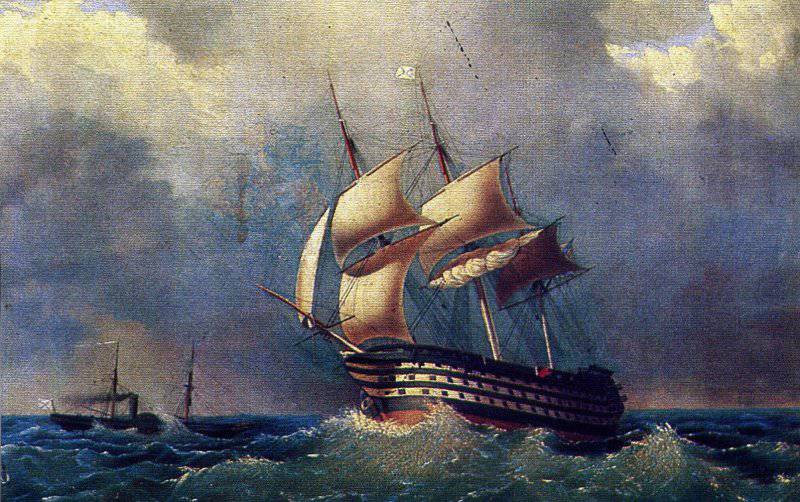
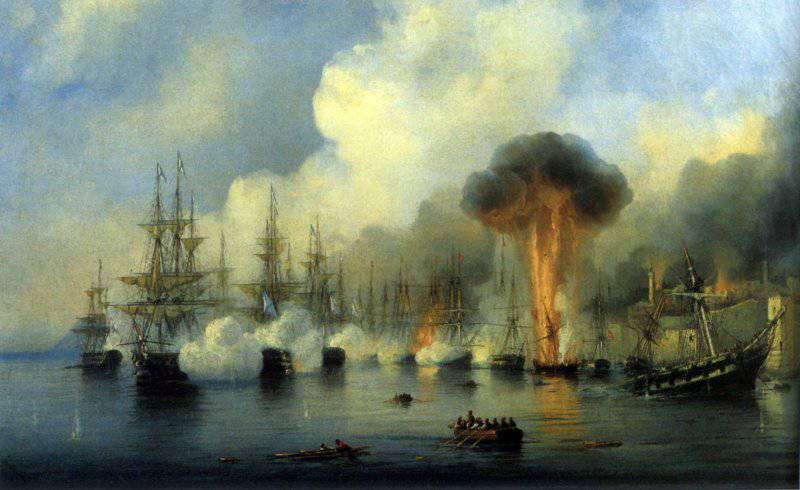
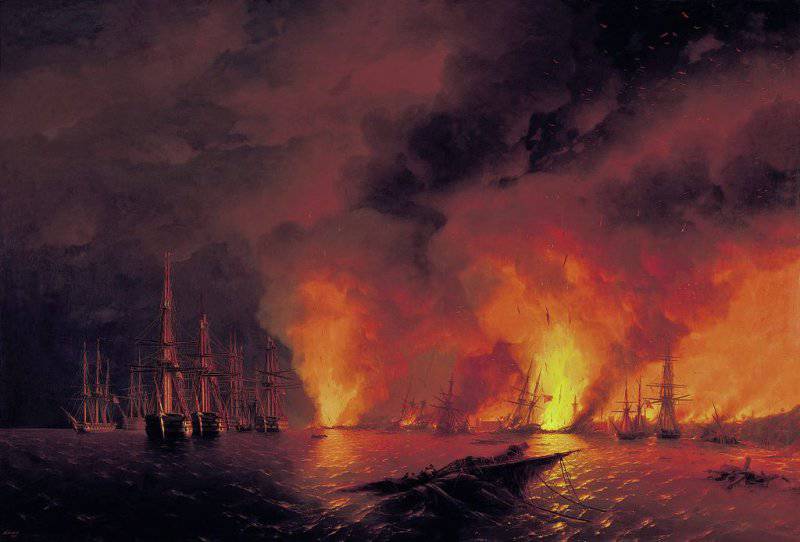
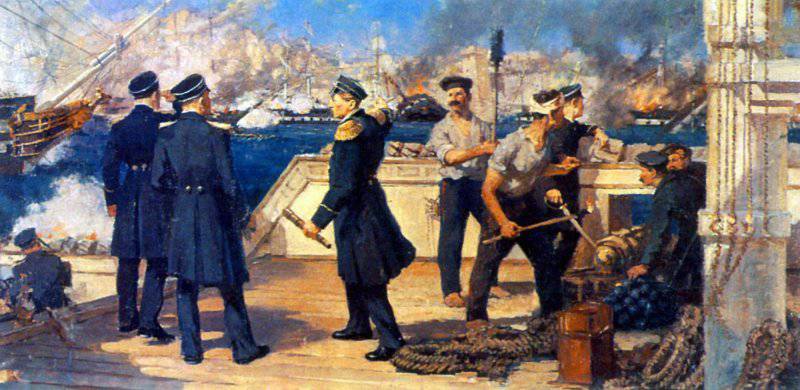
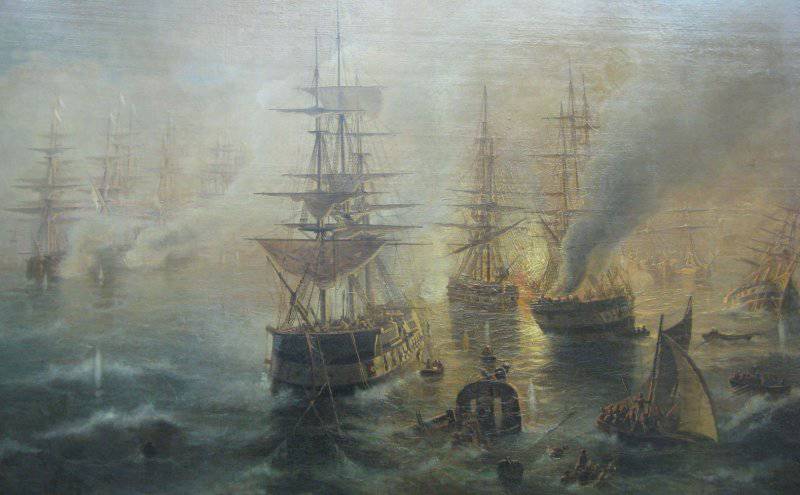
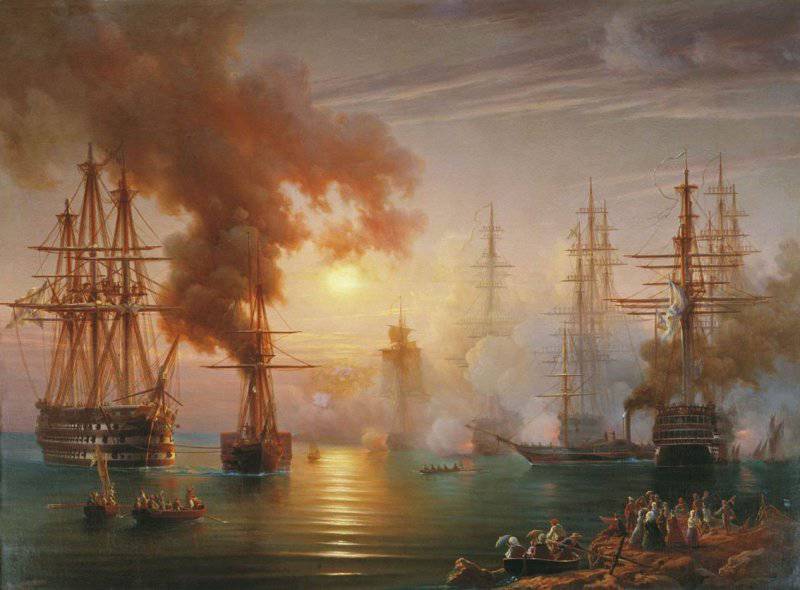
Information